A Nematode Community-Based Integrated Productivity Efficiency (IPE) Model That Identifies Sustainable Soil Health Outcomes: A Case of Compost Application in Carrot Production
Abstract
:1. Introduction
1.1. Achieving Steady-State and Sustainable Soil Health Using Agricultural Practices (APs)
1.2. The Concept of Integrated Efficiency and the Role of Nematodes
1.3. The Concept of IPE
1.4. Goals and Objectives
2. Materials and Methods
2.1. Experimental Site and Design and Compost Application
2.2. Planting, Plot Maintenance, and Harvesting
2.3. Soil Sampling and Analyses
2.4. Nematode Extraction, Identification and Enumeration
2.5. Integrating WAFG to the IPE Model
2.6. Testing WAFG to Assess Integrated Efficiency Using the IPE Model
2.7. Statistical Analysis
3. Results
3.1. Data Organization
3.2. Effect of the Compost Treatments on WAFG Prior to Expressing as Percent of Control
3.3. Effect of Compost Treatments on SOM Expressed as a Percent of Control
3.4. Effect of Compost Treatments on Soil pH Expressed as a Percent of Control
3.5. Effect of Compost Treatments on Marketable Yield Expressed as a Percent of Control
3.6. Effect of Compost Treatments on Unmarketable Yield Expressed as a Percent of Control
4. Discussion
4.1. Significance of the WAFG to the IPE Model
4.2. The Advantages of the IPE Concept in Assessing Soil Health Indicators
4.3. Comparison between Mean Separation and the IPE Model
4.4. Similarities and Differences between the IPE Model and FUE and SFW Models
4.5. Potential of the IPE Model as an Integration Platform for More Soil Health Indicators
5. Conclusions
Supplementary Materials
Author Contributions
Funding
Institutional Review Board Statement
Informed Consent Statement
Data Availability Statement
Acknowledgments
Conflicts of Interest
References
- Bulluck, L.R., III; Barker, K.R.; Ristaino, J.B. Influences of organic and synthetic soil fertility amendments on nematode trophic groups and community dynamics under tomatoes. Appl. Soil Ecol. 2002, 21, 233–250. [Google Scholar] [CrossRef]
- Doran, J.W.; Zeiss, M.R. Soil health and sustainability: Managing the biotic component of soil quality. Appl. Soil Ecol. 2000, 15, 3–11. [Google Scholar] [CrossRef] [Green Version]
- Melakeberhan, H. Effect of starter nitrogen on soybeans under Heterodera glycines infestation. Plant Soil 2007, 301, 111–121. [Google Scholar] [CrossRef]
- Neher, D. Ecology of plant and free-living nematodes in natural and Agricultural soil. Annu. Rev. Phytopathol. 2010, 48, 371–394. [Google Scholar] [CrossRef] [Green Version]
- Wang, K.H.; McSorley, R.; Kokalis-Burelle, N. Effects of cover cropping, solarization, and soil fumigation on nematode communities. Plant Soil 2006, 286, 229–241. [Google Scholar] [CrossRef]
- Habteweld, A.; Brainard, D.; Kravchenko, A.; Grewal, P.S.; Melakeberhan, H. Effects of integrated application of plant-based compost and urea on soil food web, soil properties, and yield and quality of a processing carrot cultivar. J. Nematol. 2020, 52, e2020-111. [Google Scholar] [CrossRef]
- United Sates Department of Agriculture, Natural Resource Conservation Service/Soil Health. 2018. Available online: https://www.nrcs.usda.gov/wps/portal/nrcs/main/soils/health/ (accessed on 11 February 2022).
- Lal, R. Soil Health and Climate Change: An Overview. In Soil Health and Climate Change; Singh, B.P., Cowie, A.L., Chan, K.Y., Eds.; Springer: Berlin/Heidelberg, Germany; Dordrech, The Netherlands; London, UK; New York, NY, USA, 2011; pp. 3–24. [Google Scholar]
- Melakeberhan, H.; Bonito, G.; Kravchenko, A.N. Application of nematode community analyses-based models towards identifying sustainable soil health management outcomes: A Review of the concepts. Soil Syst. 2021, 5, 32. [Google Scholar] [CrossRef]
- Carrera, L.M.; Buyer, J.S.; Vinyard, B.; Abdul-Baki, A.A.; Sikora, L.J.; Teasdale, J.R. Effects of cover crops, compost and manure amendments on soil microbial community structure in tomato production systems. Appl. Soil Ecol. 2007, 37, 247–255. [Google Scholar] [CrossRef]
- Collins, H.P.; Alva, A.; Bydston, R.A.; Cochran, R.L.; Hamm, P.B.; McGuire, A.; Riga, E. Soil microbial, fungal, and nematode responses to soil fumigation and cover crops under potato production. Biol. Fertil. Soils 2006, 42, 247–257. [Google Scholar] [CrossRef]
- García-Orenes, F.; Morugán-Coronado, A.; Zornoza, R.; Scow, K. Changes in soil microbial community structure influenced by agricultural management practices in a Mediterranean agro-ecosystem. PLoS ONE 2013, 8, e80522. [Google Scholar] [CrossRef]
- Kovacs-Hostyanszki, A.; Elek, Z.; Balazs, K.; Centeri, C.; Falusi, E.; Jeanneret, P.; Penksza, K.; Podmaniczky, L.; Szalkovszki, O.; Baldi, A. Earthworms, spiders and bees as indicators of habitat quality and management in low-input farming region—A whole farm approach. Ecol. Indic. 2013, 33, 111–120. [Google Scholar] [CrossRef] [Green Version]
- Melakeberhan, H. Fertiliser use efficiency of soybean cultivars infected with Meloidogyne incognita and Pratylenchus penetrans. Nematology 2006, 8, 129–137. [Google Scholar] [CrossRef]
- Melakeberhan, H. Assessing cross-disciplinary efficiency of soil amendment for agro-biologically, economically, and ecologically integrated soil health management. J. Nematol. 2010, 42, 73–77. [Google Scholar] [PubMed]
- Bongers, T.; Bongers, M. Functional diversity of nematodes. Appl. Soil Ecol. 1998, 10, 239–251. [Google Scholar] [CrossRef]
- Ferris, H.; Bongers, T.; De Goede, R.G.M. A framework for soil food web diagnostics: Extension of the nematode faunal analysis concept. Appl. Soil Ecol. 2001, 18, 13–29. [Google Scholar] [CrossRef]
- Melakeberhan, H.; Maung, Z.Z.; Lartey, I.; Yildiz, S.; Gronseth, J.; Qi, J.; Karuku, G.N.; Kimenju, J.W.; Kwoseh, C.; Adjei-Gyapong, T. Nematode Community-Based Soil Food Web Analysis of Ferralsol, Lithosol and Nitosol Soil Groups in Ghana, Kenya and Malawi Reveals Distinct Soil Health Degradations. Diversity 2021, 13, 101. [Google Scholar] [CrossRef]
- Habteweld, A.; Brainard, D.; Kravchenko, A.; Grewal, P.S.; Melakeberhan, H. Characterization of nematode communities in carrot fields and their bioindicator role for soil health. Nematropica 2020, 50, 200–210. [Google Scholar]
- Yeates, G.W.; Ferris, H.; Moens, T.; Van Der Putten, W. The role of nematodes in ecosystems. In Nematodes as Environmental Bioindicators; Wilson, M.J., Kakouli-Duate, T., Eds.; CABI: Wallingford, UK, 2009; pp. 1–44. [Google Scholar]
- Glavatska, O.; Muller, K.; Boutenschoen, O.; Schmalwasser, A.; Kandeler, E.; Scheu, S.; Totsche, K.U.; Ruess, L. Disentangling the root- and detritus-based food chain in the micro-food webs of an arable soil by plant removal. PLoS ONE 2017, 13, e0180264. [Google Scholar] [CrossRef] [Green Version]
- Hunt, H.W.; Coleman, D.C.; Ingham, E.R.; Ingham, R.E.; Elliott, E.T.; Moore, J.C.; Rose, S.L.; Reid, C.P.P.; Morley, C.R. The detrital food web in a shortgrass prairie. Biol. Fertil. Soils 1987, 3, 57–68. [Google Scholar] [CrossRef]
- Jangid, K.; Williams, M.A.; Franzluebbers, A.J.; Sanderlin, J.S.; Reeves, J.H.; Endale, M.B.; Coleman, D.C.; Whitman, W.B. Relative impacts of land-use, management intensity and fertilization upon soil microbial community structure in agricultural systems. Soil Biol. Biochem. 2008, 40, 2843–2853. [Google Scholar] [CrossRef]
- Ferris, H.; Tuomisto, H. Unearthing the role of biological diversity in soil health. Soil Biol. Biochem. 2015, 85, 101–109. [Google Scholar] [CrossRef]
- Ingham, R.E.; Trofymow, J.A.; Ingham, E.R.; Coleman, D.C. Interactions of bacteria, fungi, and their nematode grazers: Effects on nutrient cycling and plant growth. Ecol. Monogr. 1985, 55, 119–140. [Google Scholar] [CrossRef]
- Sánchez-Moreno, S. Biodiversity and soil health: The role of the soil food web in soil fertility and suppressiveness to soil-borne diseases. Acta Hortic. 2018, 1196, 95–104. [Google Scholar] [CrossRef]
- Domene, X.; Mattana, S.; Sanchez-Moreno, S. Biochar addition rate determines contrasting shifts in soil nematode trophic groups in outdoor mesocosms: An appraisal of underlying mechanisms. Appl. Soil Ecol. 2021, 158, 103788. [Google Scholar] [CrossRef]
- Adesemoye, A.O.; Kloepper, J.W. Plant-microbe interactions in enhanced fertilizer-use efficiency-Mini-review. Appl. Microbiol. Biotechnol. 2009, 85, 1–12. [Google Scholar]
- Baligar, V.C.; Fageria, N.K.; He, Z.L. Nutrient use efficiency in plants. Comm. Soil Sci. Plant Anal. 2001, 32, 921–950. [Google Scholar] [CrossRef]
- Fixen, P.; Brentrup, F.; Bruulsema, T.W.; Garcia, F.; Norton, R.; Zingore, S. Nutrient/fertilizer use efficiency: Measurements, current situation and trends. In Managing Water and Fertilizer for Sustainable Agricultural Intensification, 1st ed.; Drechsel, P., Heffer, P., Magen, H., Mikkelsen, R., Wichelns, D., Eds.; International Fertilizer Industry Association (IFA); International Water Management Institute (IWMI); International Plant Nutrition Institute (IPNI); International Potash Institute (IPI): Paris, France, 2015; pp. 8–38. [Google Scholar]
- Olk, D.C.; Cassman, K.G.; Simbaha, G.; Sta Cruz, P.C.; Abdulrachman, S.; Nagarajan, R.; Tan, P.S.; Satawathananon, S. Interpreting fertilizer-use efficiency in relation to soil nutrient-supplying capacity, factor productivity, and agronomic efficiency. Nutr. Cycl. Agroecosyst. 1999, 53, 35–41. [Google Scholar] [CrossRef]
- Ferguson, R.B. Groundwater quality and nitrogen use efficiency in Nebraska’s central platte river valley. J. Environ. Qual. 2015, 44, 449–459. [Google Scholar] [CrossRef] [Green Version]
- Melakeberhan, H.; Avendaño, M.F. Spatio-temporal consideration of soil conditions and site-specific management of nematodes. Precis. Agric. 2008, 9, 341–354. [Google Scholar] [CrossRef]
- Habteweld, A.W. Assessing the Impact of Compost Amendment for Managing Nematodes and the Health of Mineral Soil under carrot Production. Ph.D. Thesis, Michigan State University, East Lansing, MI, USA, 2015. Available online: http://search.proquest.com.proxy1.cl.msu.edu/docview/1728124437?pq-origsite=summon (accessed on 20 March 2022).
- Habteweld, A.W.; Brainard, D.C.; Kravchenko, A.N.; Grewal, P.S.; Melakeberhan, H. Effects of plant and animal waste-based compost amendments on soil food web, soil properties, and yield and quality of fresh market and processing carrot cultivars. Nematology 2018, 20, 147–168. [Google Scholar] [CrossRef]
- Anon, Soil Survey of Ingham County, Michigan. United State Department of Agriculture Soil Conservation Service in Cooperation with Michigan Agricultural Experimental Station, East Lansing, MI, USA, 1977. Available online: https://www.nrcs.usda.gov/Internet/FSE_MANUSCRIPTS/michigan/inghamMI1979/inghamME1979.pdf (accessed on 20 March 2022).
- Anon, United States Standards for Grade of Topped Carrots. United State Department of Agriculture, Washington, DC, USA, 1965. Available online: http://www.ipt.us.com/wp-content/uploads/2009/02/carrots-topped.pdf (accessed on 20 March 2022).
- Nelson, E.W.; Sommers, L.E. Total carbon, organic carbon, and organic matter. In Methods of Soil Analysis Part III; Sparks, D.L., Ed.; Soil Science Society of America: Madison, WI, USA, 1996; pp. 961–1010. [Google Scholar]
- Nelson, D. Determination of Ammonium in KCl Extracts of Soils by the Salicylate Method. Commun. Soil Sci. Plant Anal. 1983, 14, 1051–1062. [Google Scholar] [CrossRef]
- Avendaño, F.; Schabenberger, O.; Pierce, F.J.; Melakeberhan, H. Geostatistical analysis of field spatial distribution patterns of soybean cyst nematode. J. Agron. 2003, 95, 936–948. [Google Scholar] [CrossRef]
- Melakeberhan, H.; Maung, Z.T.Z.; Lee, C.-L.; Poindexter, S.; Stewart, J. Soil type-driven variable effects on cover- and rotation crops, nematodes and soil food web in sugar beet fields reveal a roadmap for developing healthy soils. Eur. J. Soil Biol. 2018, 85, 53–63. [Google Scholar] [CrossRef]
- Bongers, T. De Nematoden van Nederland. KNNV-bibliotheekuitgave 46; Pirola: Schoorl, The Netherlands, 1994. [Google Scholar]
- SAS Institute Inc. SAS OnlineDoc 9.3; SAS Institute Inc.: Cary, NC, USA, 2012. [Google Scholar]
- Li, X.; Lewis, E.E.; Liu, Q.; Li, H.; Bai, C.; Wang, Y. Effects of long-term continuous cropping on soil nematode community and soil condition associated with replant problem in strawberry habitat. Sci. Rep. 2016, 6, 30466. [Google Scholar] [CrossRef] [PubMed] [Green Version]
- Melakeberhan, H. Effects of nutrient source on the physiological mechanisms of Heterodera glycines and soybean genotypes interactions. Nematology 1999, 1, 113–120. [Google Scholar] [CrossRef]
- Walker, G.E. Association between carrot defects and nematodes in South Australia. Aust. Plant Pathol. 2004, 33, 579–584. [Google Scholar] [CrossRef]
- Emery, S.M.; Reid, M.L.; Bell-Dereske, L.; Gross, K.L. Soil mycorrhizal and nematode diversity vary in response to bioenergy crop identity and fertilization. Glob. Chang. Biol. Bioenergy 2017, 9, 1644–1656. [Google Scholar] [CrossRef] [Green Version]
- Fine, A.K.; van Es, H.M.; Schindelbeck, R.R. Statistics, Scoring Functions, and Regional Analysis of a Comprehensive Soil Health Database. Soil Sci. Soc. Am. J. 2017, 81, 589. [Google Scholar] [CrossRef]
- Jian, J.; Du, X.; Stewart, R.D. A database for global soil health assessment. Nat. Sci. Data 2020, 7, 16. [Google Scholar] [CrossRef] [PubMed] [Green Version]
- Kihara, J.; Bolo, P.; Kinyua, M.; Nyawira, S.S.; Sommer, R. Soil health and ecosystem services: Lessons from sub-Saharan Africa. Geoderma 2019, 370, 141342. [Google Scholar] [CrossRef]
- Liu, T.; Hu, F.; Li, H. Spatial ecology of soil nematodes: Perspectives from global to micro scales. Soil Biol. Biochem. 2019, 137, 107565. [Google Scholar] [CrossRef]
- Moore-Kucera, J.; Azarenko, A.N.; Brutcher, L.; Chozinski, A.; Myrold, D.D.; Ingham, R. In search of key soil functions to assess soil community management for sustainable sweet cherry orchards. HortScience 2008, 43, 38–44. [Google Scholar] [CrossRef] [Green Version]
- Wander, M.M.; Cihacek, L.J.; Coyne, M.; Drijber, R.A.; Grossman, J.M.; Gutknecht, J.L.M.; Horwath, W.R.; Jagandamma, S.; Olk, D.C.; Ruark, M.; et al. Developments in agricultural soil quality and health: Reflections by the research committee on soil organic matter management. Front. Environ. Sci. 2019, 7, 1–9. [Google Scholar] [CrossRef] [Green Version]
- World Fertilizer Trends and Outlook to 2022. FAO: Rome, Italy, 2018. Available online: File:///E:/MSIKAProjectPublications/Manuscripts/Review/Reading/FAO%20World%20Fertilizer%20Data%20CA6746EN.pdf (accessed on 11 February 2022).
- IPCC. Climate Change 2013: The Physical Science Basis. Contribution of Working Group I to the Fifth Assessment Report of the Intergovernmental Panel on Climate Change; Stocker, T.F., Qin, D., Plattner, G.-K., Tignor, M., Allen, S.K., Boschung, J., Nauels, A., Xia, Y., Bex, V., Midgley, P.M., Eds.; Cambridge University Press: Cambridge, UK; New York, NY, USA, 2013; p. 1535. [Google Scholar]
- The 4R Principles of Nutrient Management—Do You Really Know Them? Meister Media Worldwide, Willoughby, OH, USA, 2021. Available online: https://www.croplife.com/special-reports/crop-nutrition/4r-principles-nutrient-management-really-know/ (accessed on 11 February 2022).
- Basso, B.G.; Zhang, S.J.; Robertson, G.P. Yield stability analysis reveals sources of large-scale nitrogen loss from the US Midwest. Nat. Sci. Rep. 2019, 10, 5774. [Google Scholar] [CrossRef] [PubMed]
- Kravchenko, A.N.; Guber, A.K.; Rasavi, B.S.; Koestel, J.; Quigley, M.Y.; Robertson, G.P.; Kuzyakov, Y. Microbial spatial footprint as a driver of soil carbon stabilization. Nat. Commun. 2019, 10, 3121. [Google Scholar] [CrossRef] [Green Version]
- Takahashi, S.; Omita, J.; Nishioka, K.; Hisada, T.; Nishijima, M. Development of a prokaryotic universal primer for simultaneous analysis of bacteria and archaea using next-generation sequencing. PLoS ONE 2014, 9, e105592. [Google Scholar] [CrossRef] [Green Version]
- Bonito, G.; Hameed, K.; Krishnan, J.; Ventura, R.; Vilgalys, R. Isolating a functionally relevant guild of fungi from the root microbiome of Populus. Fungal Ecol. 2016, 22, 35–42. [Google Scholar] [CrossRef] [Green Version]
- Longley, R.; Noel, Z.A.; Benucci, G.M.N.; Chilvers, M.I.; Trail, F.; Bonito, G. Crop management impacts the soybean (Glycine max) microbiome. Front. Microbiol. 2020, 11, 1116. [Google Scholar] [CrossRef]

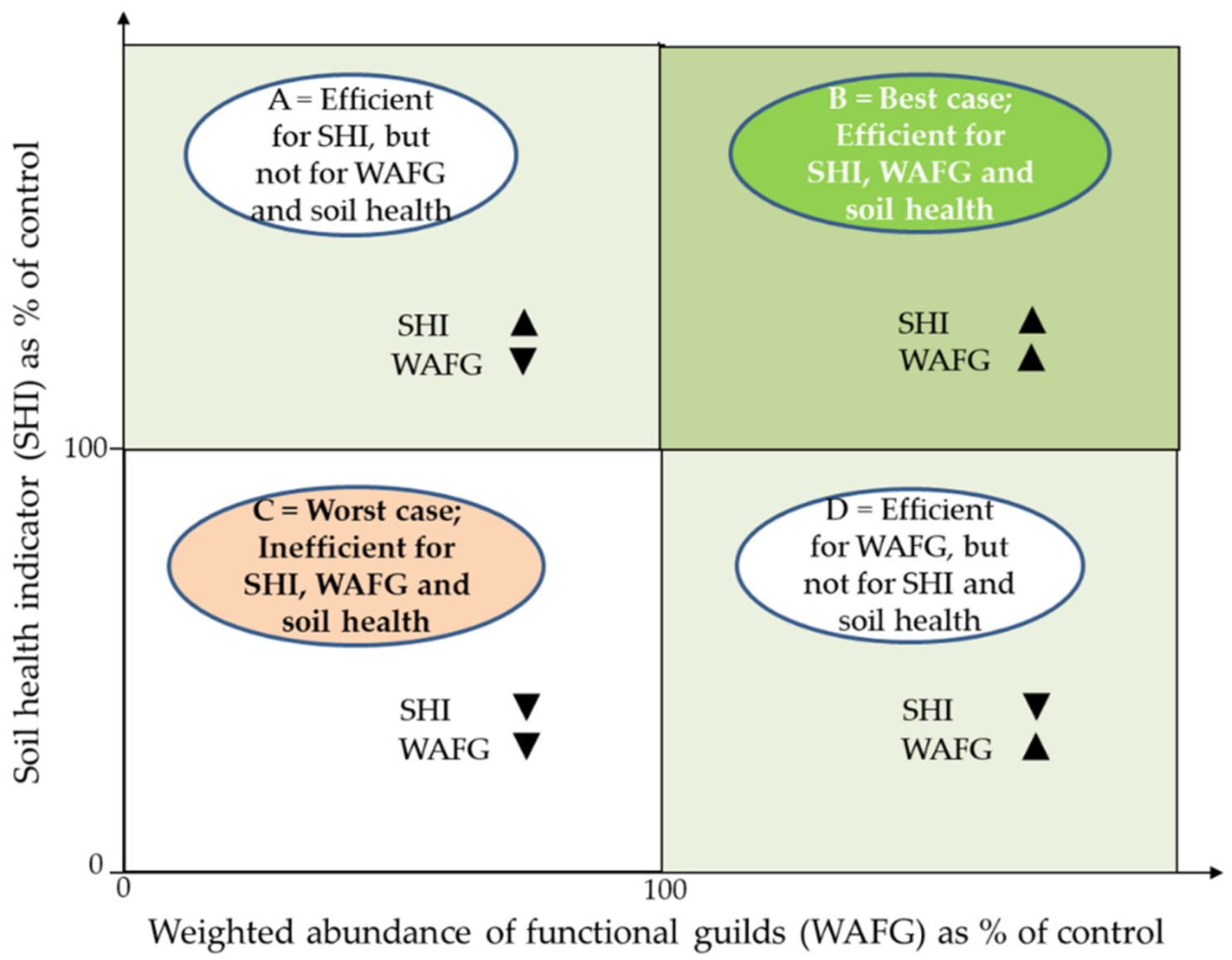
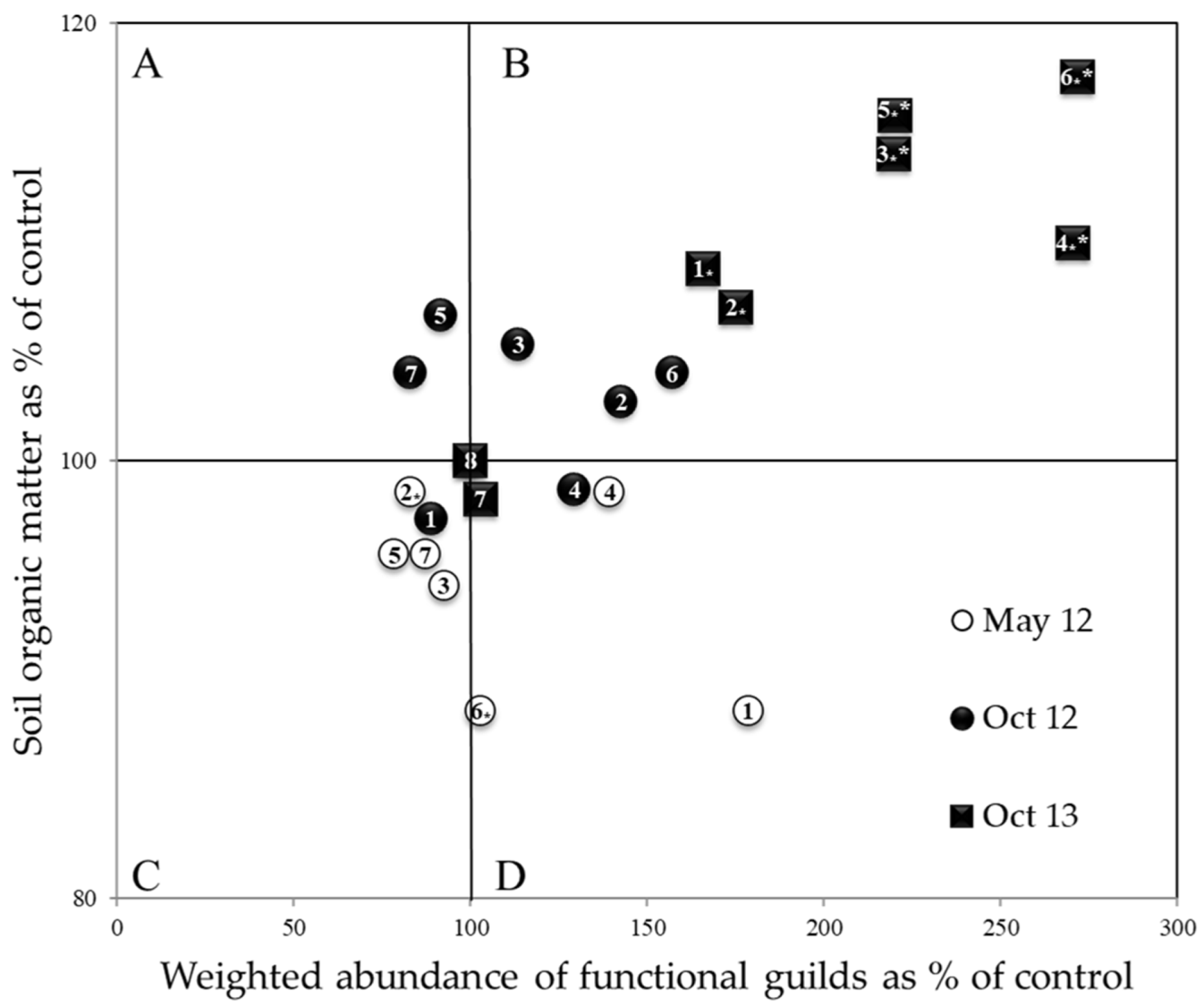
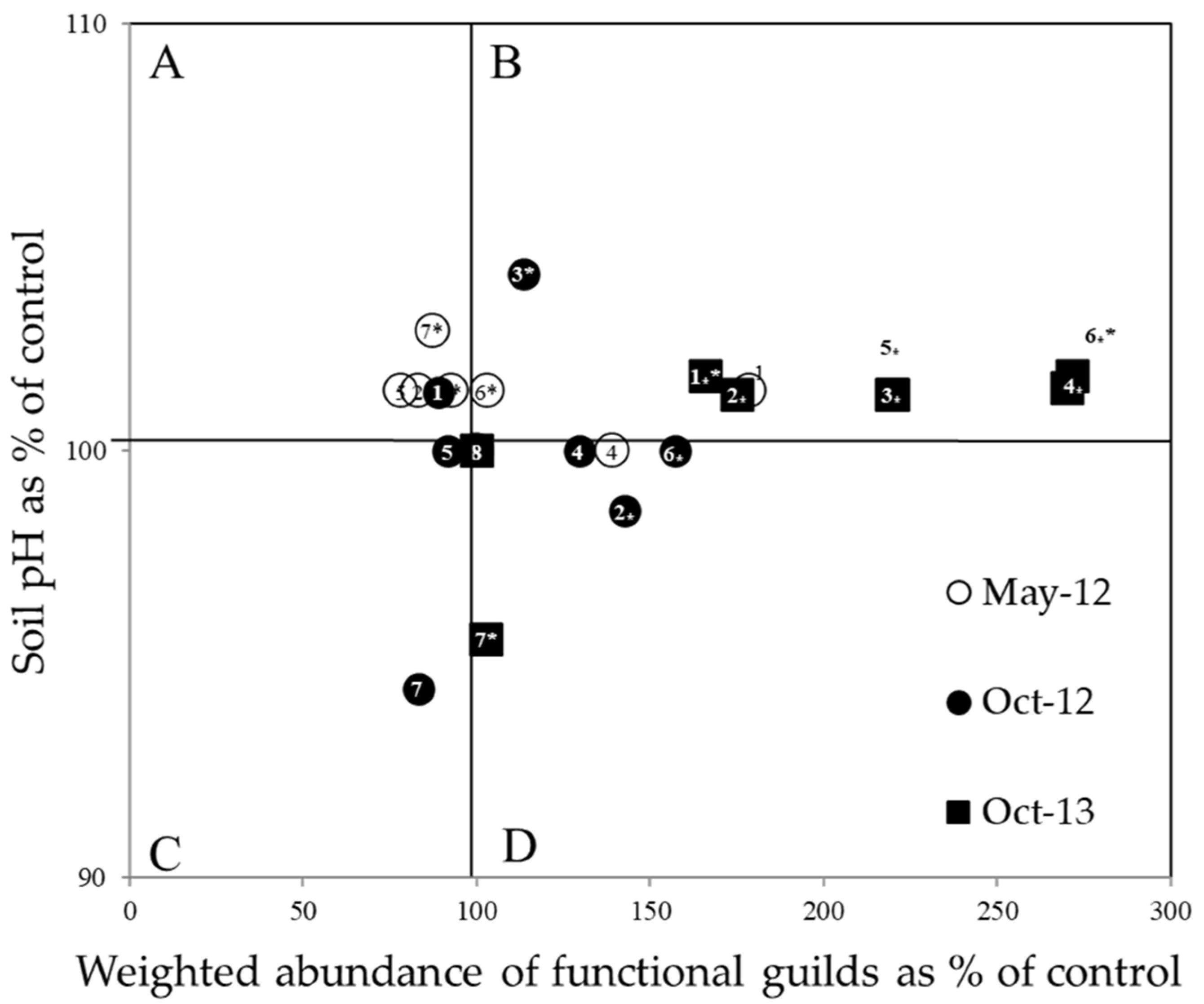
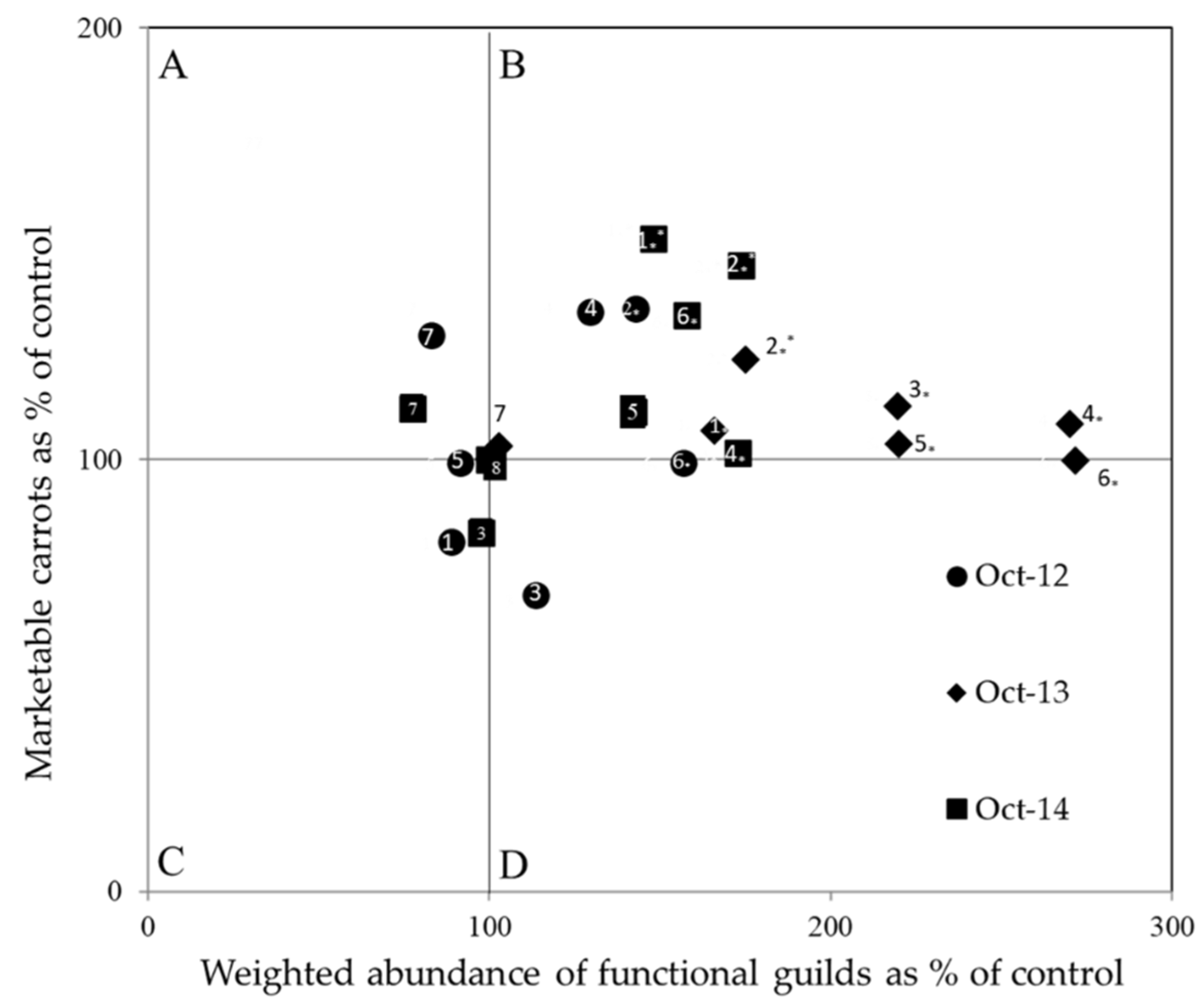
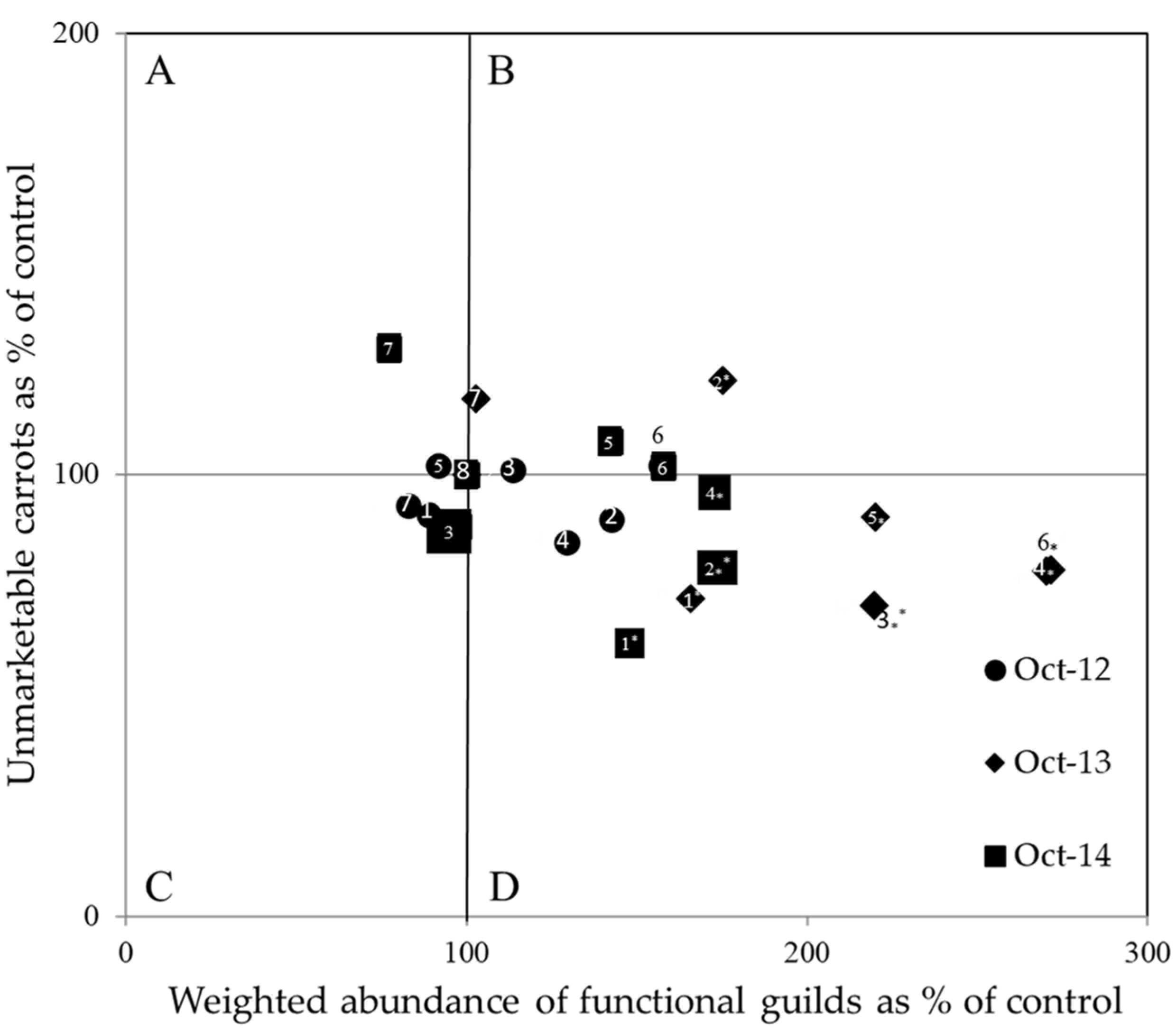
| Amendment | Years and Days after Planting (DAP) | ||||||
|---|---|---|---|---|---|---|---|
| Source | N | 2012 | 2013 | 2014 | |||
| rate | DAP † | DAP † | DAP † | ||||
| kg/ha | 0 | 132 | 0 | 133 | 0 | 133 | |
| PC | 135 | 179 aA * | 89 abAB | 51 bB | 166 aAB | 87 abA | 148 abAB |
| 203 | 83 bB | 143 aAB | 119 aA | 175 aAB | 111 aA | 174 aA | |
| 270 | 93 bB | 114 abAB | 44 cB | 220 aAB | 26 dB | 98 bcB | |
| AC | 135 | 139 abAB | 129 abcAB | 95 bcAB | 270 aA | 70 cA | 173 abA |
| 203 | 78 bB | 92 bAB | 90 bAB | 220 aAB | 82 bA | 142 aAB | |
| 270 | 103 bcB | 157 abA | 60 cB | 272 aA | 102 bcA | 158 aA | |
| Urea | 135 | 87 aB | 83 aB | 85 aAB | 103 aB | 116 aA | 77 aB |
| Check | 0 | NA | NA | NA | NA | NA | NA |
Publisher’s Note: MDPI stays neutral with regard to jurisdictional claims in published maps and institutional affiliations. |
© 2022 by the authors. Licensee MDPI, Basel, Switzerland. This article is an open access article distributed under the terms and conditions of the Creative Commons Attribution (CC BY) license (https://creativecommons.org/licenses/by/4.0/).
Share and Cite
Habteweld, A.; Kravchenko, A.N.; Grewal, P.S.; Melakeberhan, H. A Nematode Community-Based Integrated Productivity Efficiency (IPE) Model That Identifies Sustainable Soil Health Outcomes: A Case of Compost Application in Carrot Production. Soil Syst. 2022, 6, 35. https://doi.org/10.3390/soilsystems6020035
Habteweld A, Kravchenko AN, Grewal PS, Melakeberhan H. A Nematode Community-Based Integrated Productivity Efficiency (IPE) Model That Identifies Sustainable Soil Health Outcomes: A Case of Compost Application in Carrot Production. Soil Systems. 2022; 6(2):35. https://doi.org/10.3390/soilsystems6020035
Chicago/Turabian StyleHabteweld, Alemayehu, Alexandra N. Kravchenko, Parwinder S. Grewal, and Haddish Melakeberhan. 2022. "A Nematode Community-Based Integrated Productivity Efficiency (IPE) Model That Identifies Sustainable Soil Health Outcomes: A Case of Compost Application in Carrot Production" Soil Systems 6, no. 2: 35. https://doi.org/10.3390/soilsystems6020035
APA StyleHabteweld, A., Kravchenko, A. N., Grewal, P. S., & Melakeberhan, H. (2022). A Nematode Community-Based Integrated Productivity Efficiency (IPE) Model That Identifies Sustainable Soil Health Outcomes: A Case of Compost Application in Carrot Production. Soil Systems, 6(2), 35. https://doi.org/10.3390/soilsystems6020035





